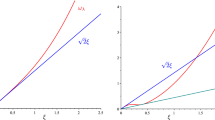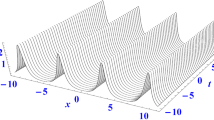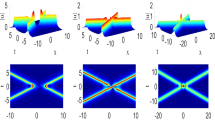Abstract
In this work, the classical \((1+1)\)-dimensional Klein–Gordon–Schrödinger (KGS) system is studied. The ansatz and the homogeneous balance principle are employed in searching for particular soliton solutions, such as bright and dark solitons. Regrettably, dark solitons cannot be captured. However, this procedure leads to a series of new singular solitons and explicit periodic wave solutions.
Similar content being viewed by others
1 Introduction
For an atomic nucleus in nonlinear media, its internal wave evolution is of considerable interest for many applications in science and modern industry technology (see, e.g., [1, 2]). Mathematical theory of propagation of a nonlinear wave for a nucleon field interacting with a neutral meson field is often based on the study of the so-called Klein–Gordon–Schrödinger (KGS) system which has the form
where \(u(x,t)\) denotes the conserved complex nucleon field, and \(n(x,t)\) represents the real scalar meson field. This system describes the dynamics of a nucleon field interacting with a neutral meson field through the Yukawa coupling [1]. Up to now, there is a series of work on global existence and asymptotic behavior for this system (1.1)–(1.2) in different topology spaces [3–9]. However, in recent years, modern physics has shown increased interest from different experimental and theoretical groups in the study of the exact solutions. The construction of exact and analytical traveling wave solutions of a nonlinear system is one of the most important and essential tasks in quantum mechanics and chaos theory [10], as these solutions describe very well the various physical phenomena, such as vibrations, solitons, and propagation with a finite speed. To this end, many reliable methods have been developed [11–17], and many interesting research results were reported.
For KGS system, Li–Yang–Wang [14] and Wang–Zhou [12] investigated the periodic wave solutions by using F-expansion method, and Wang–Xia [18] applied Exp-function method to get some generalized solitary wave solutions. Based on a series hypothesis, Darwish [13] has recently obtained multiple exact explicit solutions of the KGS system (1.1)–(1.2). However, to the best of our knowledge, there are few report on the existence of some particular physical waves, such as bright and dark solitons [19]. The main reason is that these methods always omit the original properties of this system.
Our original purpose in this paper is to find a particular type solitary wave solution. For this, we assume that the solution \((u,n)\) for the system (1.1)–(1.2) has the form \(u=f(\tau )^{p_{1}}\exp\{i\phi\}\) and \(n=g(\tau)^{p_{2}}\), respectively, where both \(f(\tau)\) and \(g(\tau)\) are the basis wave functions, \(p_{1}\) and \(p_{2}\) will be determined later by balancing the coefficients. In this paper we explicitly obtain the bright 1-solitons and the bell-shaped regular solitons with the appropriate choice of f and g. Moreover, taking into account the superposition of wave components, we also get the interacting wave \((u,n)\) having the form \(u=[f_{1}(\tau)^{p_{1}}+f_{2}(\tau )^{p_{1}}]\exp\{i\phi\}\) and \(n=g_{1}(\tau)^{p_{2}}+g_{2}(\tau)^{p_{2}}\), respectively. It is regretful that the usual dark soliton cannot be derived, because it strongly depends on the coefficients for Yukawa interaction terms. But fortunately, it may induce a large class of periodic wave solutions that would not be provided by the exposed standard methods.
2 Mathematical analysis
In order to solve (1.1)–(1.2) using the traveling wave hypothesis, it is assumed that
where \(f(\tau)\) and \(g(\tau)\) represent the solitary wave profiles, \(\tau=B\eta=B(x-vt)\) and \(\phi=-\kappa x+\omega t+\theta\). Here v is the velocity of soliton and B is the inverse width of the soliton. Also κ is the frequency of the soliton, while ω is the wave number of the soliton and θ is the phase constant. The exponents \(p_{1}\) and \(p_{2}\) are unknown real constants at this point and their values will appear in the process of deriving the solution of this model. Substituting the derivatives of u, n into equation (1.1) and decomposing into real and imaginary parts, respectively, we have
and
while equation (1.2) reduces to
In (2.2), as a necessary condition, \(v=-\kappa\) is restricted to avoid the trivial solution. In the next section, we mainly treat the rest equations (2.3) and (2.4) in different cases.
3 Solitary wave
In this section we consider the regular solitary wave for the KGS system (1.1)–(1.2) and present some particular solutions which play important roles in the physical traveling wave theory.
The first investigation is concerned with the bright soliton which has the following form:
where \(A_{1}\) and \(A_{2}\) are real and represent the amplitudes of the u- and n-soliton, respectively. Substituting (3.1) into (2.3) and (2.4), respectively, we have
and
From (3.2), equating the exponents \(p_{1}+2\) and \(p_{1}+p_{2}\) gives \(p_{2}=2\) to get a nontrivial solution. In what follows, we proceed by investigating the cases \(p_{1}=1\) and \(p_{1}=2\).
Case 1
By virtue of (3.3), the first possibility is for the exponents to satisfy \(2p_{1}=p_{2}\), that is, \(p_{1}=1\). Setting the coefficient of the linearly independent \(\frac {1}{\cosh^{p_{1}+j}\tau}\) (\(j=0,2\)) to zero in (3.2), we have
Solving the above equations, we obtain
which implies \(A_{2}> 0\) and \(\omega=\frac{A_{2}-\kappa^{2}}{2}\). In addition, from (3.3), setting the coefficients of the linearly independent function \(\frac{1}{\cosh^{p_{1}+j}\tau}\) (\(j=0,2\)) to 0, we obtain
Note that \(A_{2}B\neq0\), thus from the above algebraic equations we get
Therefore, inserting equations (3.4) and (3.5) into (3.1) leads to
where
and B is an arbitrary real nonzero constant. The above expression, as in the case of the particular physical wave, clearly shows the existence of the bright soliton for KGS system (1.1) and (1.2). The propagation profile of the bright soliton is depicted in Fig. 1.
Remark 3.1
From the solution (3.6)–(3.7), one has \(M^{2}n=|u|^{2}\), which suggests \(n_{tt}-n_{xx}=0\). Setting \(u=p+iq\), this system becomes
In fact, the KGS system reduces to a system of conservation laws \(\partial_{t} T+\partial_{x} S=0\) with \(T=\frac{1}{2}(p^{2}+q^{2}+2n_{t})\) and \(S=-\frac{1}{2}p_{x}q+\frac{1}{2}pq_{x}-n_{x}\).
Case 2
In (3.3), one can have \(2p_{1}=p_{2}+2\), that is, \(p_{1}=2\). In a similar way to Case 1, one has the following equations:
which yields
with \(A_{2}> 0\) and \(v^{2}<1\). Moreover, we obtain \(3M^{2}A_{2}=2A_{1}^{2}\). In this case, the soliton solution of (1.1)–(1.2) can be written as
where
Figure 2 presents the propagation process of the soliton solution. This solution is the so-called bell-profile solitary wave, which is also reported in the existing literature [17, 18].
Remark 3.2
This solution has a strong space location requirement. Indeed, any tiny upper and lower translation is ineffective, that is, if one sets \(u(x,t)=(A_{1}\operatorname{sech}^{p_{1}}\tau +C_{1})\exp\{i\phi\}\) and \(n(x,t)=A_{2}\operatorname{sech}^{p_{2}}\tau+C_{2}\) with real constants \(C_{1}\) and \(C_{2}\), then one can deduce that \(C_{1}=C_{2}=0\) with \(p_{1}=1\) or 2 and \(p_{2}=2\).
As \(\operatorname{sech}^{2}(\alpha-i\pi/2)=-\operatorname{csch}^{2}(\alpha)\), shifting x by \(i\pi /2\) in \(u_{2}\), \(n_{2}\), we obtain
with ϕ, ω and v as in (3.12). Similar to the bell-shaped soliton, any tiny change of the amplitude for this solution is not allowed, although the shock wave brings about the singularity along some characteristic direction (e.g., \(x-vt=0\)). The evolution of the real part for u and \(|n|\) is displayed in Fig. 3.
Using the formula \(\operatorname{csch}^{2}(\alpha)-\operatorname{sech}^{2}(\alpha)=4\operatorname{csch}^{2}(2\alpha)\), we can get
with ϕ, ω and v as in (3.12) as well.
Remark 3.3
We will also attempt to find a dark soliton of the form \(u=A_{1}\tanh(\tau)\exp\{i\phi\}\) and \(n=A_{2}\tanh ^{2}(\tau)\). It is regretful that the homogeneous balancing technique cannot produce a nontrivial solution because it strongly depends on the sign of the coefficients for Yukawa interaction terms. However, we can deduce a solution with \(\tanh(\tilde{B}(x-vt))+\tilde{C}\) where B̃ is a pure imaginary number. Noting that \(\tanh(ix)=i\tan x\), we will then have the solution in Sect. 4.
4 Periodic wave
The search for the dark solitons shows the existence of a solution with the form \(\tanh(i\tilde{B}(x-vt))+\tilde{C}\) (see Remark 3.3), which inspires us to exert fresh efforts.
It is well known that \(\tanh(ix)=i\tan x\) and that \(\tanh(i\tilde {B}(x-vt))\) type solution implies the existence of a tangent wave of KGS system (1.1)–(1.2). As a generalization, here we consider the following translation wave:
where \(A_{1} \), \(A_{2}\), \(C_{1} \), \(C_{2} \), \(p_{1} \), \(p_{2}\) are real and \(C_{1}\), \(C_{2}\) are free nonzero parameters. Substituting the derivatives of u, n into (1.1) and (1.2) yields
and
An effective matching and the independent 0-coefficients for \(\tan ^{p_{1}+j}\tau\) (\(j=-2,0,2\)) show \(p_{1}=p_{2}=2\) and the equations
which produce \(B^{2}=-\frac{A_{2}}{3}\). And from (4.4)/\(A_{1}\)–(4.5)/\(C_{1}\), we can obtain \(-\frac{4}{3}+\frac{C_{1}}{A_{1}}=-\frac{A_{1}}{3C_{1}}\) which yields \(\frac{C_{1}}{A_{1}}=1\) or \(\frac{C_{1}}{A_{1}}=\frac{1}{3}\). Moreover, in (4.3), setting the coefficients of the function \(\frac {1}{\tan^{p_{2}+j}\tau}\) (\(j=-2,0,2\)) to 0, we have
From (4.9), we have \(A_{1}^{2}=-2A_{2}^{2}(v^{2}-1)\) for \(v^{2}-1<0\). Equations (4.7)–(4.8) reduce to
If \(\frac{C_{1}}{A_{1}}=1\), form (4.11), we get \(A_{2}=\frac {2A_{1}^{2}}{3M^{2}}>0\), which contradicts \(B^{2}=-\frac{A_{2}}{3}\). Otherwise, if \(\frac{C_{1}}{A_{1}}=\frac{1}{3}\), we have \(C_{2}=\frac{1}{3}A_{2}=-\frac{2A_{1}^{2}}{9M^{2}}\). Hence, the solution of KGS system (1.1)–(1.2) is given by
where
and K is an arbitrary real nonzero constant. For the propagation of the solution, one can refer to Fig. 4.
As \(\tan^{2}(\alpha-\pi/2)=\cot^{2}(\alpha)\), shifting x by \(i\pi/2\) in \(u_{5}\), \(n_{6}\), we have
with ϕ, ω and v as in (4.14). This solution admits a similar periodical change process as for the tangent type wave.
Using the formula \(\cot^{2}(\alpha)+\tan^{2}(\alpha)=4\cot^{2}(2\alpha )+2\), we also have
with ϕ, ω and v as in (4.14) as well.
5 Conclusion
In this paper, the ansatz method is applied to the \((1+1)\)-dimensional KGS system for some particular solitary waves, and a series of explicit exact solutions are constructed. Most of them cannot be derived by the existing standard procedures, particularly, the bright solitons and singular wave that play essential role in plasma and fluid physics. More importantly, their amplitudes are not only strongly dependent on the wave speed, but also related to the mass of the meson. As for the existence of dark solitons of another form, we will make further discussion in the forthcoming work.
References
Yukawa, H.: On the interaction of elementary particles I. Proc. Phys. Math. Soc. Jpn. 17, 48–57 (1935)
Sakurai, J.J.: Modern Quantum Mechanics, 2nd edn. Pearson Education, Upper Saddle River (2013)
Cavalcanti, M.M., Cavalcanti, V.N.D.: Global existence and uniform decay for the coupled Klein–Gordon–Schrödinger equations. Nonlinear Differ. Equ. Appl. 7, 285–307 (2000)
Fukuda, I., Tsutsumi, M.: On the Yukawa-coupled Klein–Gordon–Schrödinger equations in three space dimensions. Proc. Jpn. Acad. 51, 402–405 (1975)
Colliander, J., Holmer, J., Tzirakis, N.: Low regularity global well-posedness for the Zakharov and Klein–Gordon–Schrödinger systems. Trans. Am. Math. Soc. 360, 4619–4638 (2008)
Guo, B., Li, Y.: Asymptotic smoothing effect of solutions to weakly dissipative Klein–Gordon–Schrödinger equations. J. Math. Anal. Appl. 282, 256–265 (2003)
Shi, Q., Li, W., Wang, S.: Kato-type estimates for NLS equation in a scalar field and unique solvability of NKGS system in energy space. J. Differ. Equ. 256, 3440–3462 (2014)
Shi, Q., Wang, S.: Nonrelativistic approximation in the energy space for KGS system. J. Math. Anal. Appl. 462, 1242–1253 (2018)
Shi, Q., Wang, S., Li, Y.: Existence and uniqueness of energy solution to Klein–Gordon–Schrödinger equations. J. Differ. Equ. 252, 168–180 (2012)
Shi, Q., Peng, C.: Wellposedness for semirelativistic Schrödinger equation with power-type nonlinearity. Nonlinear Anal. 178, 133–144 (2019)
Alves, C.O., Souto, M.A.S., Soares, S.H.M.: Schrödinger–Poisson equations without Ambrosetti–Rabinowitz condition. J. Math. Anal. Appl. 377, 584–592 (2011)
Wang, M.L., Zhou, Y.B.: The periodic wave solutions for the Klein–Gordon–Schrödinger equations. Phys. Lett. A 318, 84–92 (2003)
Darwish, A., Fan, E.G.: A series of new explicit exact solutions for the coupled Klein–Gordon–Schrödinger equations. Chaos Solitons Fractals 20, 609–617 (2004)
Li, X.Y., Yang, S., Wang, M.L.: The periodic wave solutions for the \((3+1)\)-dimensional Klein–Gordon–Schrödinger equations. Chaos Solitons Fractals 25, 629–636 (2005)
Santanu, S.R.: An application of the modified decomposition method for the solution of the coupled Klein–Gordon–Schrödinger equation. Commun. Nonlinear Sci. Numer. Simul. 13, 1311–1317 (2008)
Yomba, E.: On exact solutions of the coupled Klein–Gordon–Schrödinger and the complex coupled KdV equations using mapping method. Chaos Solitons Fractals 21, 209–229 (2004)
Xia, J.N., Han, S.X., Wang, M.L.: The exact solitary wave solution for the Klein–Gordon–Schrödinger equations. Appl. Math. Mech. 23, 58–64 (2002)
Wang, Y.P., Xia, D.F.: Generalized solitary wave solutions for the Klein–Gordon–Schrödinger equations. Comput. Math. Appl. 58, 2300–2306 (2009)
Afanasyev, V.V., Kivshar, Y.S., Konotop, V.V., Serkin, V.N.: Dynamics of coupled dark and bright optical solitons. Opt. Lett. 14, 805–807 (1989)
Acknowledgements
The authors wish to thank the referees for their valuable comments.
Funding
This work is supported by the Development Program of Hongliu First-Class Disciplines in Lanzhou University of Technology.
Author information
Authors and Affiliations
Contributions
QS conceived of the study and drafted the manuscript. SC carried out the theoretical computation. XZ participated in the design and coordination. JC carried out the modifications and participated in its final design. All authors read and approved the final manuscript.
Corresponding author
Ethics declarations
Competing interests
The authors declare that they have no competing interests.
Additional information
Publisher’s Note
Springer Nature remains neutral with regard to jurisdictional claims in published maps and institutional affiliations.
Rights and permissions
Open Access This article is distributed under the terms of the Creative Commons Attribution 4.0 International License (http://creativecommons.org/licenses/by/4.0/), which permits unrestricted use, distribution, and reproduction in any medium, provided you give appropriate credit to the original author(s) and the source, provide a link to the Creative Commons license, and indicate if changes were made.
About this article
Cite this article
Shi, Q., Chang, S., Zhang, X. et al. Solutions induced from bright solitons for nucleon–meson model. Adv Differ Equ 2018, 363 (2018). https://doi.org/10.1186/s13662-018-1831-4
Received:
Accepted:
Published:
DOI: https://doi.org/10.1186/s13662-018-1831-4








